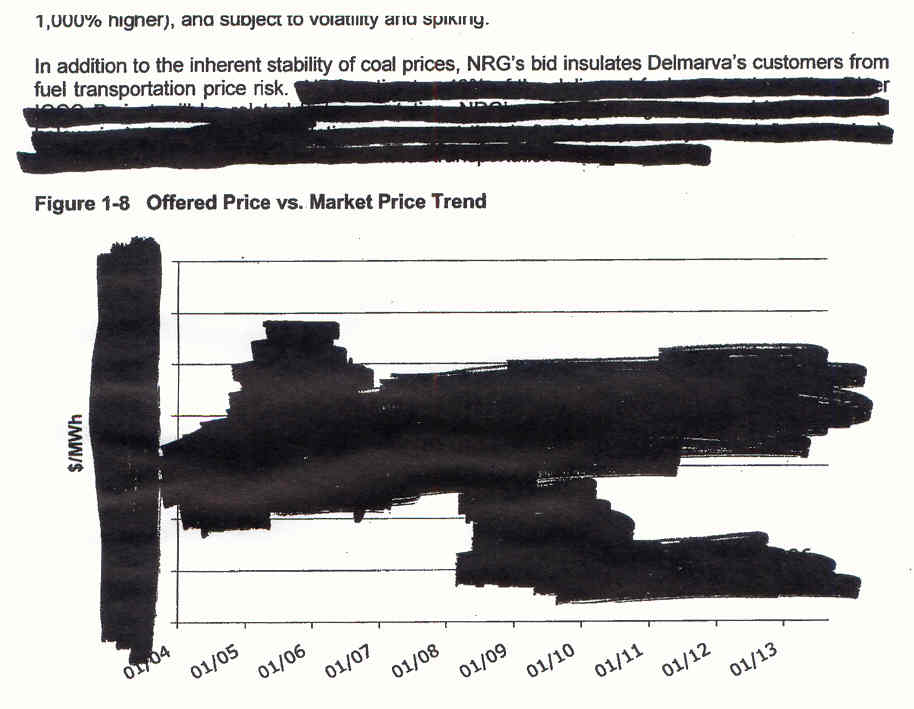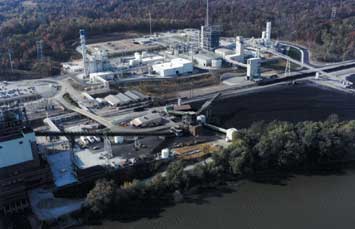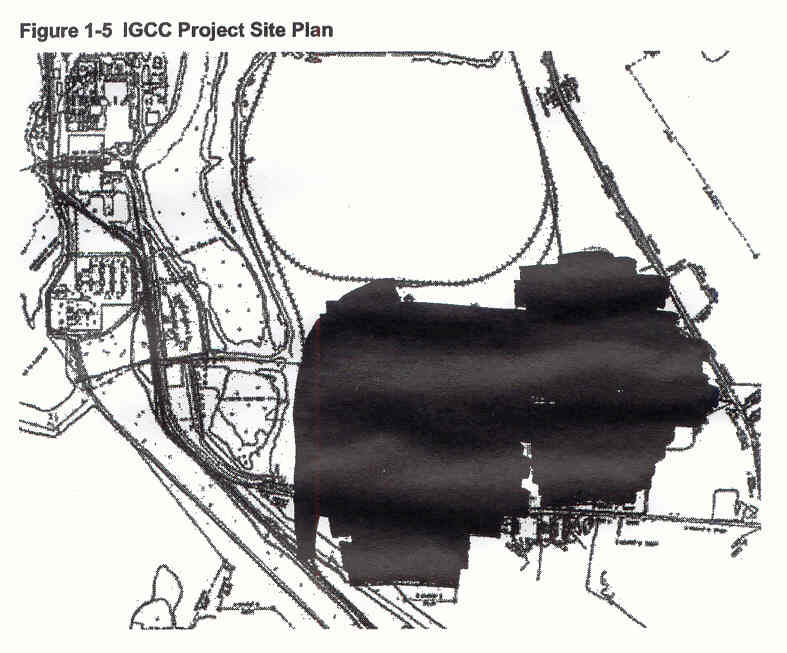IGCC doesn’t cut it in Delaware
March 10th, 2007

BEWARE — THE POST YOU ARE ABOUT TO VIEW IS QUITE GRAPHIC!
Coal gasification, wind, and natural gas, OH MY!!! And nobody’s touting IGCC, well, except for the obvious toadies…
LOTS going on in Delaware this last week, they’ve got their Integrated Resource Plan dragging behind an ill-advised but mandated RFP for electricity they don’t need! I’ll start out with the IRP/RFP articles and then the coverage of public comment meetings that were held this week. Dig this, the meetings were to be on Tuesday, Wednesday and Thursday, and the Wednesday one was cancelled because of “weather.” 1/2 inch of snow… really, 1/2 inch. What would happen if they got hit with the 24″ we got here in the two storms the week before last.
The first is about the continuing saga of redacted information. There are three proposals in response to the RFP, and all three are redacted beyond comprehension. Redaction and secrecy about information in applications isn’t anything new. Companies even hide under the cover of third party confidentiality contracts to keep necessary information from the public. It happened here in Minnesota, where we had to fight to get information made public, and even Xcel Energy, with all their power (why do you think they call them power companies?) couldn’t free up the basic cost of the plant! Maybe that info will become public, but it’s going to take more public pressure.
They’ve finally posted the Comments on the request of PSC — it’s odd, the PSC is asking “How should we do this” and THERE ARE NO RULES!! Hello! They need a rulemaking. The PSC’s Bob Howatt told an Regulatory Assistance Project interviewer that there were to be rules coming out in the spring of 2007. SEE RAP INTERVIEW HERE. So why are they doing an IRP without rules, before the rules come out. Is this a way to force a result, or shut out the public? It may be both! SOMEBODY PETITION FOR A RULEMAKING!! SOMEBODY GET A LEGISLATIVE MANDATE FOR A RULEMAKING!!! (…sigh… that’s the lawyer talking…)
NRG made some pretty absurd statements about efficiency (yes, it is filed under “NRG stupid statements” — NRG’s Steve Corneli knows better than this!!!):

NRG clearly hasn’t a clue. Check out RAP’s Efficiency Policy Toolkit for some basics that work and examples from around the country.
And about that redacted Information: This is what the site plan in the NRG proposal looks like, really, it’s this cheezy!
And this is their coal pricing. Coal price inherently stable? Hmmmm… in December 2005 the price of coal tripled… could their short-term memory loss be attributable to mercury…

The Daily Times/News Journal reported on efforts to wrench the proposal open to the public — and it looks like details may be made public week after next — IT’S ABOUT TIME. Leave a comment below their article so they know how you feel about the secrecy:
Details of power plant may see light
By Jeff Montgomery
The News JournalPublic Service Commission staffers are expected to call for the release of a substantial amount of information being withheld by companies vying to build a new power plant, a top commission official said.
The information — including how the projects would be financed, costs of electricity they would generate and the amount of pollution they would emit — has been blacked-out from documents because the companies claim releasing it would put them at a competitive disadvantage.
But several individuals and organizations have called for the release of details because the state’s formula for choosing the winning bidder is based solely on financial and pollution information.
Those calls were rebuffed until Bruce Burcat, the executive director of the Public Service Commission, said the agency was reviewing the documents with an eye toward recommending release of details at its March 20 meeting.
“There will be a number of documents and line items that have been redacted that will be recommended to be released to the public,” Burcat said.
The documents were generated by Bluewater Wind LLC, Conectiv Power and NRG Energy, companies that have filed separate, dramatically different plans for supplying Delmarva Power with energy. Lawmakers ordered the process after electricity rates increased 59 percent last year for residential customers.
Critics of the process say that the public has been wrongly shielded from crucial bid information on rates, reliability and the environmental impact.
“It needs to be opened up more. Absolutely,” said Letitia L. Diswood, co-president of the League of Women Voters of Delaware. “I think it’s a very technical, complicated issue. It’s very hard to make simple for the public, but it’s extremely important.”
The PSC already began the process of accepting public comment on the proposals without releasing crucial details. More public hearings are scheduled for next week and next month.
It even made WMDT TV — KEEP THE PRESSURE ON:
PSC wants more details from companies proposing power plants
And now, on to coverage of the well-attended public meetings:
Del. energy bids debated; Public weighs in on choices for power
By Kate House-Layton, Delaware State News
DOVER — Tuesday was the first of three public comment sessions the state Public Service Commission has scheduled in connection with bids three energy companies have submitted to Delmarva Power and the state for new electric generation in Delaware.
Most of the comments Tuesday at Legislative Hall in Dover supported Blue Water Wind’s offshore Atlantic wind farm generation proposal or NRG’s proposal to expand the Indian River power plant in Millsboro to include coal gasification generators.
Conectiv, a sister company to Delmarva Power, has proposed a natural gas-fired generator in New Castle County.
Conectiv’s bid last month won the most points from Delmarva Power and the state’s independent consultant reports.
Delmarva Power said it opposed all three bids. The state’s report gave no recommendation.
NRG supporters, mostly NRG employees or retirees, touted the reliability a coal-generated power plant provides.
“Wind is a pretty hip, sexy energy option,†Delaware resident and NRG employee Doug Netting.
Wind, however, is intermittent, he said.
On low wind days, electric companies would have to pluck energy off the grid using whatever is available that day. Most of the time electricity from coal-fired plants would be on tap.
Jim Sadowski, NRG’s environmental manager for the Indian River power plant, said it would take gale-force winds to create three megawatts of electricity.
Julie Rigby of Seaford said the wind farm proposal concerned her for potential dangers to birds that migrate along the coast.
Several environmentalists, however, strongly supported wind power.
The state’s independent consultant report said Blue Water Wind could provide price stability, but was more expensive.
Federal emission taxes, medical bills and public health outweigh a price on an electric bill, some said.
“The economic evaluation of price benefit is shortsighted,†said Kim Furtado, a Millsboro resident and doctor of natural medicine. “It does not access the benefits we will gain by acknowledging the health costs with generating power.â€
Connie Peterson of Lewes and others pointed to the volatility of fossil fuel costs.
“They cannot guarantee stability,†she said.
Jim Black, director of Community Outreach for the Delaware Clean Air Council, said gas prices continue to fluctuate and fossil fuel costs likely will rise.
“The wind will still blow for free,†he said.
If there was any consensus, it was that something had to be done about electricity in Delaware.
Delmarva Power representatives last month said that instead of new generation, it favored conservation strategies, continuation of a new east-west transmission line and increasing its portfolio to more renewable energy sources from the existing power grid.
Residents disagreed.
“Inaction is not the answer,†said Wilmington resident Harry Gravell, who represented Delaware builders.
“It would be a big mistake to do nothing, we have to change,†Vincent Ascione of Sussex County said.
Delmarva Power spokesman Tim Brown afterward said that the utility stands by its recommendation. The company previously said it did not find that any of the bids would economically benefit its customers.
PSC panelist Jeffrey Clark and PSC executive director Bruce H. Burcat said they were impressed with the public comments and said the panel would give them strong consideration when it comes time to make a recommendation.
Two more hearings are scheduled.
Tonight’’ meeting will be at the Delaware Technical & Community College’s theater at the Owens campus in Georgetown.
Thursday’s hearing will be in the auditorium of the Carvel State Office Building at 820 French St., Wilmington.
Both meetings start at 7 p.m.
Here’s another, this one from News Journal, and be sure to add your comments here too:
By AARON NATHANS, The News Journal
Posted Friday, March 9, 2007Wind-power advocates packed a public hearing Thursday night on whether to build a new power plant to meet Delaware’s long-term energy needs.
The event, held at the Carvel State Office Building in Wilmington, attracted a full room of about 160 people. They were commenting on a state consultant’s report that said Conectiv’s proposed 180-megawatt natural gas plant was the best among three options.
But most of the speakers early in the evening focused on the environmental harm that could be caused by a new plant that burns fossil fuels such as natural gas or coal. NRG is proposing a coal gasification plant.
Most of the speakers instead said they liked a proposed wind farm that would feature 200 turbines in the Atlantic Ocean off Rehoboth Beach or Bethany Beach.
“The conventional wisdom is that the public’s environmental interest is in conflict with the public’s economic interest,” said Tom Noyes, of Wilmington. “But my review of the record leads me to believe that the conventional wisdom has been turned on its head in this case. Burning more fossil fuels doesn’t make economic or environmental sense for Delaware.”
And Ellen Lebowitz of Newark said global climate change could wreak havoc on the state’s coastline.
“Wind is here. It’s free from nature. We can harvest it now,” she said.
Several people spoke up for the NRG proposal. Robert Carl, business manager of Local 42 of the Heat & Frost Insulators & Asbestos Workers, praised the potential of “clean coal” to produce a “ripple effect” in the economy by creating good paying jobs.
“NRG’s commitment to clean fuel seems to be on the right path,” he said.
The event was sponsored by the Public Service Commission. The commission, along with three other state agencies, is expected to recommend within the next several months whether to proceed with one of the proposed power plants. The hearing was the last of three public hearings this week.
The commission is expected to hold more public hearings later in the process.
Some speakers criticized the commission and the three companies for redacting information from their bids so the public could not see it. NRG, for instance, redacted information about exactly how much pollution its proposed plant would send into the air.
Lisa Pertzoff of the League of Women Voters said the bids were lacking “key environmental and cost data.” The consultant reports had so much jargon, even the most informed members of the public could not understand them, she said. Such problems potentially undermined public confidence in the result, she said.
Delmarva Power is recommending against all the proposals, saying they would not be cost-effective. The company can meet its needs by a combination of conservation, buying on the wholesale market, and improving the region’s power infrastructure, it says.
Contact Aaron Nathans at 324-2786 or anathans@delawareonline.com.
At least 11,500MW mothballed in Texas
February 24th, 2007

Speaking of mothballed fleets… Now we all know that Texas wants to build a gazillion or two megawatts of new coal plants. It’s bad enough that they propose coal plants, and now NRG jumps into the fray and proposes a coal gasification (IGCC) plant. I’ve been talking and emailing with a bunch of people down there of all power plant persuasions, because why aren’t they doing wind and gas combo like we’ve started here? Or wind and concentrated solar given the solar and land resource. In the midst of this, it occurred to me that I’d better take a look at the NERC report and see what they had to say about ERCOT, the Texas region. Well I did, and land sakes, OH MY DOG, so should you!!!
The juicy bit, from p. 15:
However, approximately 7,000 MW of existing mothballed generating capacity is not included as vailable capacity that could potentially be brought back into service in a short time frame.
Did y’all know that five or so years ago they shut down more than a dozen gas-fired plants? NERC reports that now, there are 7,500MW mothballed in ERCOT! And we know NERC is very conservative. AEP shut down a bunch, it’s hard to get a handle on it , one articles says they shut down 1,628 and are looking at another 2,253MW. CenterPoint shut down 3,400MW. TXU shut down 3,612 at least. In 2006, a PSC Commissioner reported that 11,500MW (link GONE, grrrr) was mothballed:
11,500 MW of inefficient, high-heat-rate units retired or mothballed. 1,100 MW of mothballed units have been returned to service for summer 2006.
Suffice it to say, there’s a lot of gas plants sitting around, and I’ll bet Mr. Gas Turbine World has a bunch of turbines to get those plants humming.
Can someone explain to me why anyone would recommend all these new $2 billion coal plants when there’s all this wind already in Texas that could be built around these mothballed plants and use them for back up to the wind? Just LOOK at all the wind:
Or better yet, think about all the open spaces, no trees, and cover it with PV or concentrated solar:
Coal? Whatever are they thinking? Tens of thousands of megawatts of coal?
Next — well, it could take a while, but I want to see a map of where those mothballed plants are compared to the new coal plants and considering “need” if they even bother to claim need. Something tells me we’re being hoodwinked.
IGCC in NYT, & Excelsior ALJ recommendation due
February 21st, 2007

Today, the ALJs’ recommendation to the Commission is due in the Excelsior Mesaba Project docket, the one where Excelsior is trying to force a PPA on Xcel. While we’re all waiting huddled around our computers, here’s some evidence of the shifting tide, the awakening of cerebellums ruminating about IGCC:
 February 21, 2007
Cleaner Coal Is Attracting Some Doubts
By MATTHEW L. WALD
WASHINGTON, Feb. 20 — Within the next few years, power companies are planning to build about 150 coal plants to meet growing electricity demands. Despite expectations that global warming rules are coming, almost none of the plants will be built to capture the thousands of tons of carbon dioxide that burning coal spews into the atmosphere.
Environmentalists are worried, but they put their faith in a technology that gasifies the coal before burning. Such plants are designed, they say, to be more adaptable to separating the carbon and storing it underground.
Most utility officials counter that the gasification approach is more expensive and less reliable, but they say there is no need to worry because their tried-and-true method, known as pulverized coal, can also be equipped later with hardware to capture the global warming gas.
But now, influential technical experts are casting doubts on both approaches.
“The phrases ‘capture ready’ and ‘capture capable’ are somewhat controversial,†said Revis James, the director of the energy technology assessment center at the Electric Power Research Institute. “It’s not like you just leave a footprint for some new equipment.â€
Many experts outside the industry share his concerns.
A major new study by faculty members at the Massachusetts Institute of Technology, scheduled for release soon, concludes in a draft version that it is not clear which technology — the so-called integrated gasification combined cycle or pulverized coal — will allow for the easiest carbon capture, because so much engineering work remains to be done.
“Other than recommending that new coal combustion units should be built with the highest efficiency that is economically justifiable, we do not believe that a clear preference for one technology or the other can be justified,†the draft concludes. The M.I.T. study said it was critical that the government “not fall into the trap of picking a technology ‘winner.’ â€
The study leader, Ernest J. Moniz, a former assistant secretary of energy in the Clinton administration, was more blunt. “Clearly in a lot of discussions, I.G.C.C. has been anointed as the solution,†he said referring to integrated gasification combined cycle. He made his comments at a symposium organized by the Aspen Institute in Washington last fall. “We certainly don’t agree with that.â€
Retrofitting either a gasification or pulverized coal power plant is not just a matter of adding new equipment and it might be impractical, the experts say. Temperatures and pressures would be designed to be in one range for a plant that captured its carbon, and another if it merely produced electricity with minimum use of fuel. Less fuel means less carbon dioxide production.
Adding carbon capture later also has implications for power supply. Early estimates are that carbon capture will require so much energy that it could reduce plant output by 10 to 30 percent.
Some experts say that the best choice may vary according to the type of coal used. Coal with high moisture content may be less suitable for gasification.
The technical assessment is certainly at odds with the hopes expressed by environmentalists. The TXU Corporation of Dallas is planning a fleet of huge new coal plants of the pulverized variety. In Austin, Tex., Tom Smith, a researcher at Public Citizen, who is helping lead the opposition, said, “It’s clear that coal gasification is by far preferable to building traditional pulverized coal plants.†On Tuesday a Texas District court judge blocked a plan by the governor to “fast track†TXU’s application.
Getting carbon out of the gas stream before combustion must be easier, Mr. Smith said, because the post-combustion gases in a pulverized coal plant are 160 times as great.
Some utility executives agree. David Crane, the chief executive of NRG Energy, said that at some point engineers might work out an economical way to capture carbon after combustion in a pulverized coal plant, but that does not exist now.
Because carbon regulation is coming, he said, gasification plants will be needed.
“For the next generation, it’s clear to me that rather than build a bunch of pulverized coal plants, with their 50-year life, the country is much better off if we go to I.G.C.C.,†he said. The company is planning such a plant in Tonawanda, N.Y.
Others point out that carbon capture from gas made from coal has proved workable, at least at a relatively small nonpower plant that manufactures methane, but that it is still unproved at a large power plant. They say the only way to prove its feasibility is to go ahead now, rather than simply build plants to be modified later.
“There is no reason to wait,†Robert H. Socolow, a professor at Princeton who is an expert on carbon capture, said in an e-mail message. “We are going to learn on the job.â€
Some environmentalists dispute the need for new coal plants, but unless there is very rapid progress soon in realizing energy efficiencies or developing the ability to extract and store huge amounts of wind and solar power at reasonable cost, more coal plants seem certain. Compared with cleaner fossil fuels, like natural gas and oil, coal is cheaper and more widely available. So finding a way to capture the greenhouse gases from these plants is critical.
At American Electric Power, which plans to build two gasification plants and add carbon separation later, Bruce H. Braine, the vice president for strategic policy analysis, acknowledged that there was a “retrofit factor†that would raise the price of such a plant above the cost of waiting a few years and building in the separation technology from the start. But because there is demonstrable evidence that separating carbon from gasified coal would work better than at a pulverized coal plant, he said, “we think it’s the right thing to do to move the I.G.C.C. technology forward.â€
Engineers agree that it is easier to remove sulfur, mercury, particles and other conventional pollutants from plants that use gasification. But they are more expensive to build, and the industry has little experience with their reliability. Even the manufacturers concede this.
“It will work,†Randy Zwirn, the chief executive of Siemens Power Generation, said of the ability to separate carbon from a gasified coal plant. “The question is, Can it be done economically?â€
Power companies need to start getting experience in this field, he said, but they will need subsidies or agreements with state regulators to avoid being unfairly penalized for testing designs that turned out not to run very well, at least not at first. Otherwise, he said, they would stick with tried-and-true methods and the early steps to a truly revolutionary technology might never be taken.
John Thompson, director of the Coal Transition Program at the Clean Air Task Force, an environmental group, argued that coal gasification was superior because it allowed far better control of conventional pollutants, like mercury, and because it offered new ways of making money from coal-fired plants. For example, he said, they might use a gasifier that made fuel for a power generator during peak hours, and in off-peak hours made gas that could be turned into liquid fuel for vehicles or other valuable chemicals.
But at the Electric Power Research Institute, which surveys the technologies for low-carbon generation, Steve Specker, the president, refers to a “horse race†between pulverized coal and combined cycle.
For all the questions about the coal technologies, any new plant should at least be an improvement on what is operating now. The reason is that many plants now running require about 10,000 B.T.U.’s of heat to make a kilowatt-hour. But newer designs, called “supercritical,†use hotter steam, with no moisture, and get more work out of it.
The newest designs, which the industry calls “ultra supercritical,†push down the amount of heat needed to make a kilowatt-hour; engineers expect to reach the range of 7,500 B.T.U.
This will be small consolation, however, if the total number of kilowatt-hours rises sharply at the same time that reducing carbon emissions becomes a national goal.
Copyright 2007 The New York Times Company
Privacy Policy
Ray weighs in, and Silberbauer, Pat would like to recall…
January 10th, 2007
.

UPDATE: Pat Silberbauer says he hit “reply all” but was referring to an internal message. Oh, OK… whatever.
And in case you missed it, here’s Garvey’s letter:
If that doesn’t leave you scratching your head…
================================
From the continuing Excelsior Mesaba Project saga — Hot off the inbasket:
Silberbauer, Pat would like to recall the message, “Digital document”.
The only thing sent recently by Pat Silberbauer was “The Garvey Letter” at 3:43 p.m. on Monday. Does this mean “Recall the Garvey Letter?” But there’s no letter attached withdrawing the paper copy. I’m soooo confused… so I sent the following missive to all:
I’m confused — please clarify!
I swear to Dog, the missive arrived just as I was trying to describe to someone how this case is “perversely hilarious.” Then this comes in… almost bust a gut laughing. What are we supposed to do? Somebody please explain! Do we recall all the articles written about the Garvey Letter, bring in copies of the paper and get our $0.50 back? Does this apply to the copy I scanned in and sent around, distinct from the ditigal copy emailed Monday at 3:43 p.m.? Does this apply to comments made over the digital phone line?
===================
And on another vein, moments before, someone else commented:
There is a (possibly) similar situation in Delaware. There is an RFP for generation and an IGCC proposal (from NRG) is competing with a wind proposal and maybe others. The coal burner people are saying in effect that they don’t want the cost of capture and sequestration included in their bid–which would then be uncompetitive–but they want to be able to pass those costs directly through to the public in the future should they arise….
It does sound similar, the pleadings have similar themes, no doubt about it. Wanting to sell more than is needed, talk of “stability of price,” Imputed Debt Offset issues, it seems their consultant in that case has identified some common issues.
=========================
And here’s what Ray Cox, former 25B Representative says, and yes, he is indeed saying that Garvey said that it’s all a matter of GRAMMAR! I’ve urged him to read the testimony and briefs of the parties. Sent links. Remember, Ray was a coauthor of the Mesaba bill, which did a LOT more than “offer some grants.” It EXEMPTED the plant from Certificate of Need review, not just for the plant but for as many plants as they want and all the transmission they want. They gave it the power of eminent domain — a PRIVATE company got the power of eminent domain. Selective memory, unfortunately, does not change the leiglsaiton. It’s too late for the “we have to see” line, when the farm was given away in 2003 — now we’re fighting to assure this boondoggle isn’t built:
Please, Ray, do your homework. Commerce’s and the MPCA’s review shows it’s not significantlly cleaner, air emissions wise, than a SCPC plant. You gave them approval without knowing about the particulars of this plant and then later would not do anything to amend that legislation. Now we’re dealing with this mess that you gave us. And don’t worry, I know that Sen. Steve Murphy amended your bill into the Prairie Island bill, and he’s accountable for this too. It’s going down in flames, but it never should have gotten this far. As a coauthor of that bill, you’ve got a responsibility to Minnesotans.
Please, go to www.mncoalgasplant.com and read the Commerce brief. Read MCGP’s and Xcel’s brief.
Read the MPCA emissions profile.
MPCA Testimony of Jackson
MPCA Emissions Profile
Reread the Prairie Island/Mesaba Bill here.
Once you’ve reviewed the reality that is Mesaba, can you even offer qualified support?
Correcting that AP article
December 19th, 2006
Here’s one LTE printed in the Winona Daily News about that AP article on Dec. 9 around the state that misstated the construction cost of the Mesaba coal gasification (IGCC) project as $1.2 billion. Haven’t heard from AP, so haven’t a clue if they’re doing anything about it.
Mesaba Project not what you think
By Carol A. Overland, Red Wing, Minn.
Excelsiorâ??s Mesaba Project isnâ??t as presented. The tax credit is not only for Mesaba, and your article about the tax credits for the project left an important unanswered question. First, the Mesaba project will cost at least $2.15 billion, almost twice the $1.2 billion reported. Secondly, and as important, Excelsiorâ??s â??preferred siteâ? is nowhere near the Hoyt Lakes brownfield originally proposed â?? itâ??s in the woods near Taconite, Minn., where the only infrastructure is pine roots and granite. Excelsior is shifting the infrastructure costs to local government, and to bring the forested site to specs for this industrial project is an expensive proposition. Third, Excelsior co-presidents Tom Micheletti and Julie Jorgensen did not both work for NSP; instead they both worked for NRG, â??Minnesotaâ??s Enron,â? the independent power producer and NSP spin-off that went bankrupt and almost took down Xcel.
The costs to the public are tremendous, from $10 million from the Renewable Development Fund, $9.5 million from the IRR, $36 million from the DOE, whatever millions that state and local governments pay out for dedicated Mesaba infrastructure, and DOE federally guaranteed loans because the project is deemed too risky for private investment. Excelsior is trying to force Xcel to buy the power produced by this plant â?? power Xcel does not need or want. To do this, Excelsior has filed a petition with the Public Utilities Commission, and the PUC is evaluating whether it is a least-cost resource and whether the proposed agreement is in the public interest. This public interest determination that the PUC will make takes into account factors such as weighing the costs and benefits of economic development in the state and whether the project offers a stable price. Given the criteria, itâ??s hard to imagine any scenario where the PUC would regard the project in the public interest. The question related to the power purchase agreement that the article did not answer is this: If Excelsior does receive a DOE tax credit, will it be incorporated into the proposed power purchase agreement and credited to ratepayers, or does it go to the company, shareholders and investors?
Overland is the attorney for landowners affected by Excelsiorâ??s Mesaba Project
And as far as costs go, I forgot to add in that $21 million from the DOE… I knew there was more...


